Prayer Man is the unknown man standing close to the western wall in Darnell’s and Wiegman’s films. Sean Murphy [1] has demonstrated that the most logical explanation of Prayer Man’s identity was that the man in question was Lee Harvey Oswald, the alleged assassin of President Kennedy. The possibility of Oswald being Prayer Man has been opposed by several researchers arguing that Prayer Man was a woman of 5’3” or a man 5.6”; these two solutions assumed that Prayer Man or Woman stood on the top landing, in the shadow cast by the western wall.
To shed more light on the location of Prayer Man in Darnell’s film, I have reconstructed the doorway of the Texas School Book Depository in SketchupPro 15/16 (Trimble Navigation, Ltd., USA). The detailed 3D model of the doorway was encased into a schematic model of the first floor of the Depository building, and aligned with Dealey Plaza in GoogleEarth (Google Inc., USA). The alignment of the 3D model with the GoogleEarth map of Dealey Plaza allowed to reconstruct the exact doorway shadows cast by both the top and western wall on November 22, 12.31 hour.
To fit a human figure into the doorway to match Prayer Man in Darnell’s still, the spatial landmarks have been extracted from Darnell’s still for two human figures, Mr. Buell Wesley Frazier and Prayer Man. The fitting of Mr. Frazier was important for both increasing the validity of the proposed solution and obtaining a useful landmark provided by Mr. Frazier’s figure [2].
My solution assumed the following for Mr. Frazier’s figure:
1. Mr. Frazier was 6’ tall. 2. Mr. Frazier stood on the top landing. This assumption is obvious based both on Mr. Frazier’s testimonies and interviews, and the analysis of Darnell’s still. 3. The left vertical rail of the middle door pane crossed Mr. Frazier’s body in the posterior part of his head. 4. Mr. Frazier had his head in the shadow. The shadow appeared to touch his left shoulder.
As far as Prayer Man is concerned, the following constrains have been obtained by inspecting Darnell’s still:
1. Prayer Man stood close to the western wall and had his head and trunk in the shadow. 2. The back of Prayer Man’s right hand reflected the sun light. 3. Prayer Man’s hands are flexed in elbow joints and form a prayer gesture. 4. The top of Prayer Man’s head aligns with Frazier’s neck. 5. The vertical corner rail of the door frame crosses Prayer Man’s head and body.
Solution 1. This solution assumes that Prayer Man was a man sized 5’9”, and matches Sean Murphy’s conclusion about Oswald being Prayer Man. Figure 1 shows a cropped view of the doorway in Darnell’s still (top panel) and the suggested solution matching all accepted constrains and assumption for both Mr. Frazier and Prayer Man. Figure 2 is identical to Figure 1, however, it also shows guidelines and markers allowing to check that the 3D doorway indeed matched the Darnell’s doorway.
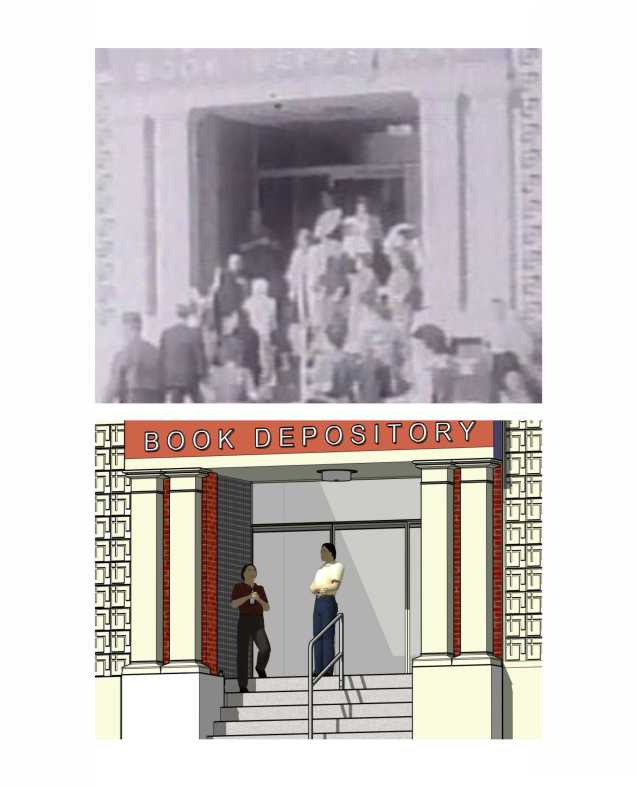
Figure 1: Top panel shows a cropped view of Darnell’s still zoomed on the doorway. This picture allows to check the constrains specifying Mr. Frazier’s and Prayer Man’s locations. The bottom panel shows both figures, Mr. Frazier in light colour polo shirt and Prayer Man in red-brown shirt in the doorway. The orientation and view of the doorway match the doorway in Darnell’s still.
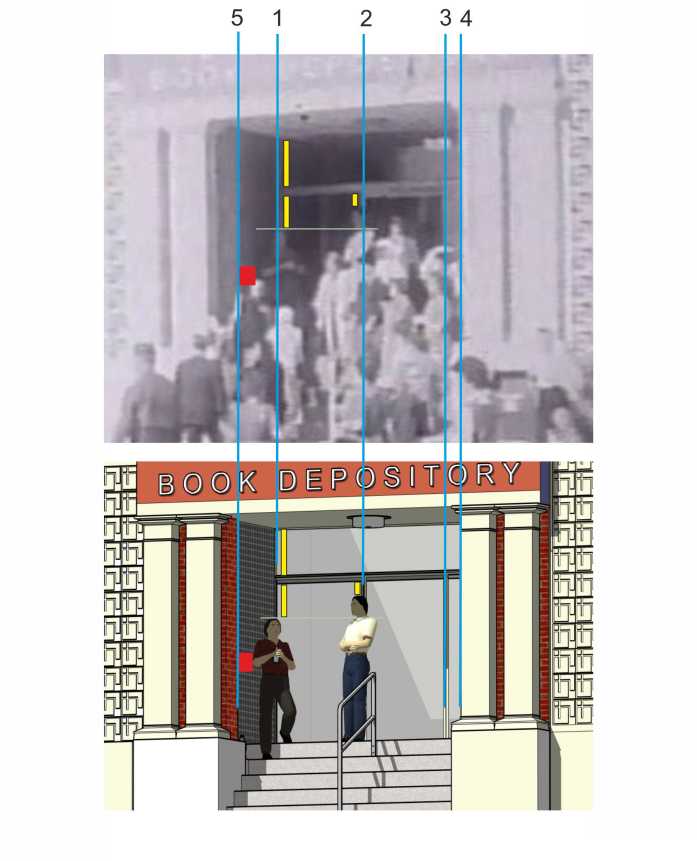
Figure 2: The top panel shows the cropped view of Darnell’s still, and the bottom panel shows the 3D model with figures of Mr. Frazier and Prayer Man. The vertical blue lines numbered 1-5 cross the top picture at selected points that align with five markers: 1. the vertical corner rail of the door frame, 2. the left (when viewed from the front) vertical rail of the middle door pane, 3. the right vertical rail of the glass door, 4. the left edge of the vertical column at the eastern side of the main entrance, 5. the right edge of the vertical column at the western side of the main entrance.
After aligning both doorways, a manikin representing Mr. Frazier has been placed on the top platform to match Mr. Frazier’s figure in Darnell’s still. This has been achieved by first observing the alignment of Mr. Frazier’s figure with the door rail in such a way that the vertical rail crossed Mr. Frazier’s head. The distance between the top of Mr. Frazier’s head and the horizontal rail in Darnell’s picture has been measured by filling the gap with a yellow vertical bar; this bar has been then copied to the model doorway in the lower panel. This step allows to check that the vertical landmarks in both doorways also matched well. Finally, the shadows seen on Mr. Frazier’s head and shoulder in Darnell’s still and in the 3D model were compared.
In the next, the figure of Prayer Man was fitted. A number of preliminary solutions involving placing Prayer Man on the top landing have been tested and rejected because Prayer Man always appeared too tall relative to Mr. Frazier’s neck line (please see Solutions 2-3). A solution in which Prayer Man would stand with both his feet on the first step was unsatisfactory because his body would not align with the western wall. Eventually, the solution in which Prayer Man stood with his right foot on the first step and with his left foot on the top landing (Figures 1 and 2) has been accepted as the only solution fulfilling all accepted constrains: 1. Prayer Man stands in the shadow cast by the western wall in such a way that his head and trunk are in the shadow. 2. A small part of Prayer Man’s right hand reflects the sun light. 3. Prayer Man’s arms in the 3D model form a prayer gesture comparable to the gesture seen in Darnell’s still. 4. The top of Prayer Man’s head aligns with Mr. Frazier’s neck and left shoulder. A horizontal green line connects the top of Prayer Man’s head and Mr. Frazier neck line in both pictures to demonstrate the match. 5. The corner rail of the door frame crosses Prayer Man’s head and body at the entry point in Prayer Man’s left part of the head. To document further the match between Darnell’s still and the 3D model, two additional vertical yellow bars have been placed into Darnell’s still (Figure 2, top panel). These bars stand for the height of the horizontal pane and the distance between the top of Prayer Man’s head and the horizontal rail, respectively; both rectangles were copied and pasted at homologous places in the 3D doorway. The yellow bars of identical lengths at equivalent locations in both doorways provide further assurance that the figure of Prayer Man in the 3D model matched accurately. Finally, the red square next to Prayer Man’s right elbow joint and defining the distance to the edge of the red brick column has been first placed into Darnell’s still and then copied and pasted at equivalent location in the 3D model. Please note that Prayer Man in Darnell’s still has his sleeved rolled up which creates an impression that his elbow was further away from the red brick column in Darnell’s still than in the 3D model.
Detailed views of the preferred “one-foot-down-one-foot-up” solution are illustrated in Figures 3-6.
Figure 3: A detailed view of Darnell’s doorway scene with Prayer Man and Mr. Frazier.
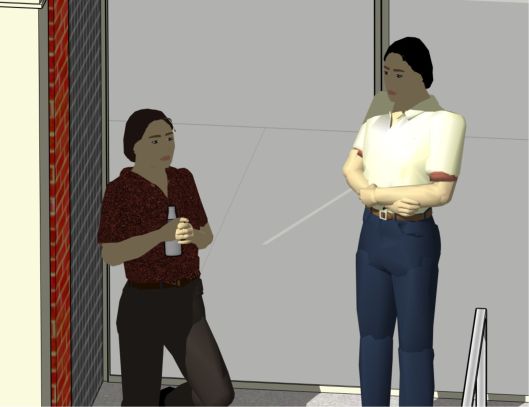
Figure 4: A close-up view of Prayer Man and Mr. Frazier from a front view.
Figure 5: Full front view of Prayer Man and Mr. Frazier at their locations seen in Darnell’s film.
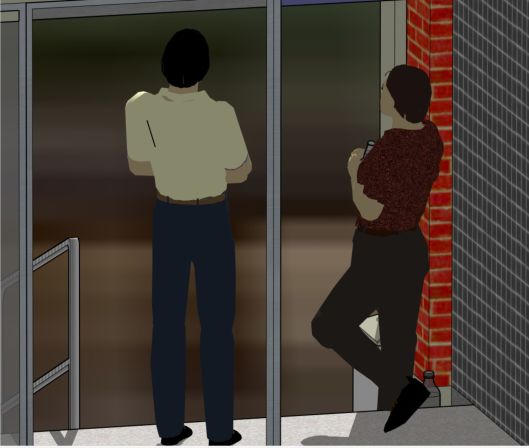
Figure 6: Prayer Man and Mr. Frazier viewed through the transparent glass door.
Solution 2. This solution assumes that Prayer Man was a man 5’9” and stood on the top landing. Solution 2 matched all accepted constrains but one: the relative height of the top of Prayer Man’s head and Mr. Frazier’s neck line. Figure 7 illustrates this solution in detail. Prayer Man was placed at a similar location as Prayer Man in the “one-foot-down-one-foot-up” solution but moved one step upwards. Placing a man 5’9” anywhere within the shadow area close to the western wall faced the same problem (not shown).
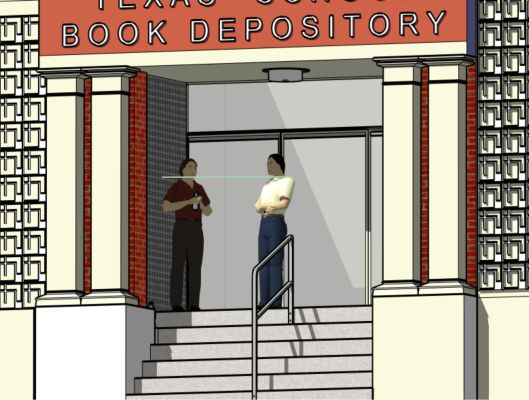
Figure 7: Solution 2 assumes that Prayer Man was a man 5’9” and stood on the top platform. The horizontal green line crosses Mr. Frazier’s neck and left shoulder; this line aligns with the top of Prayer Man’s head in Darnell’s still (Figures 1 and 2) but not in Solution 2.
Solution 3 Prayer Man was a man 5’6” and stood on the top landing. This solution encountered a similar problem as Solution 2 – the man of this height would still be too tall relative to Mr. Frazier’s neck line (Figure 8).
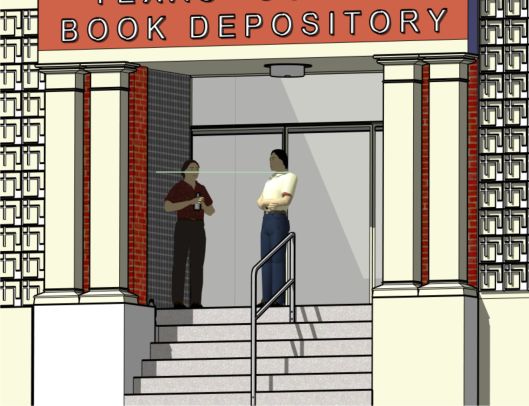
Figure 8: Prayer Man as a man measuring 5’6” and standing on the top landing. Similar to Solution 2, Prayer Man would be too tall relative to the line crossing Mr. Frazier’s neck and left shoulder. Thus, Solution 3 does not explain Prayer Man’s location in Darnell’s still.
Solution 4: Prayer Woman measuring 5’3” stood on the top landing. For the sake of comparison with previous solutions, the same manikin that was used in previous solutions was also used in this solution. The manikin was proportionally reduced to match the body height of 5’3”. Reducing proportionally the manikin’s figure entailed a reduction of the antero-posterior size of manikin’s body which meant that his arms have not been exposed to the sun light. To achieve the bright reflection on his hand, this manikin had to be moved slightly outwards.
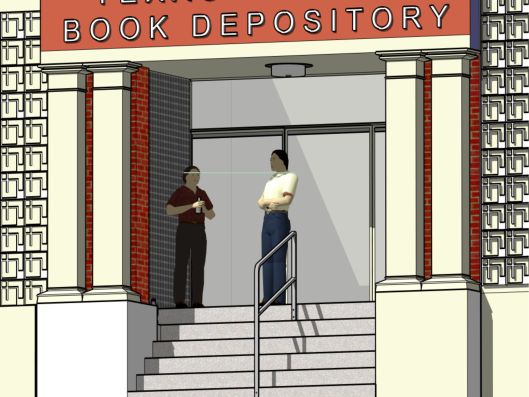
Figure 9: Solution 4 which assumes that the human form seen in Darnell’s still was a woman measuring 5’3”. Note that this solution also failed the height criterion which stipulated that the top of Prayer Man’s head would be aligned with Mr. Frazier’s neck line.
Four different solutions each attempting to explain the location of Prayer Man in Darnell’s film have been examined in this article. None of the solutions assuming Prayer Man (Woman) standing on the top platform of the Depository doorway fulfilled all four criteria which are evidenced in Darnell’s stills. All three solutions placing Prayer Man on the top landing failed the height criterion which required that the relative height of Prayer Man’s head was at the level of Mr. Frazier’s neck line. The only solution which met all criteria including the height criterion was the “one-foot-down-one-foot-up” solution (Solution 1). Please note that Prayer Man could not stand with both his feet on the first step as his body would be orientated in parallel with the plane of the glass door rather than with the plane paralleling the western wall. Further, should Prayer Man stand with both feet on the first step, his left shoulder would be exposed to the sun light.
My analysis shows that Prayer Man was most likely a man measuring 5’9”, which was the body height of Lee Harvey Oswald. Further, my analysis suggests that the “one-foot-down-one-foot-up” solution explains Prayer Man’s location better than any alternative solution. Does this mean a proof for the claim that Prayer Man was Oswald? A 3D model remains a model – an approximation of reality. The value of the model is in the visualisation and evaluation of alternative solutions, and highlighting the most likely solution. However, every model needs to be validated empirically before it is accepted as a truthful representation of reality. Empirical validation would entail shooting Darnell’s scene with a camera of identical or similar focal length and from the exact point at which Darnell had stood whilst filming the doorway. People matching the height of Oswald, Mr. Frazier and perhaps a man 5’6” and a woman 5’3” should pose in the doorway at locations suggested by the 3D model. If the reenactment pictures would accord the predictions of the 3D model, the validity of the proposed solution would be strengthened beyond any doubts.
Limitation.
The position of the left forearm in the 3D model appears to differ slightly from the one seen in Darnell’s still. It is possible that Prayer Man held another object in his left hand and his hands did not touch each other as alluded to in my model. I will investigate this point further, and would update the solution if new evidence would emerge allowing to decide about the object(s) in Prayer Man’s hands.
Footnotes:
[1] Sean Murphy published a number of original research notes in his posts at Spartacus Educational Forum, thread “Oswald leaving the TSBD? in 2013.
[2] This research appeared earlier at Spartacus Educational Forum, thread “Prayer Person-Prayer Man or Prayer Woman? Research Thread.”, post 137, dated April 5, 2016. I am grateful to Mr. Sandy Larsen and Mr. Ray Mitcham from the Spartacus Educational Forum for their comments which helped, in an important way, to refine the preferred solution.
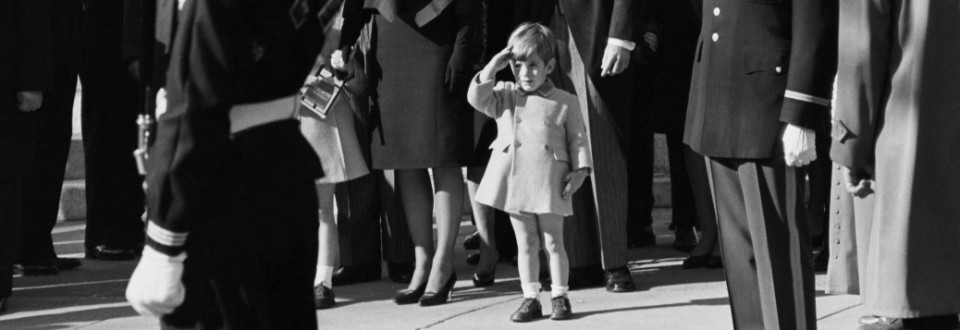
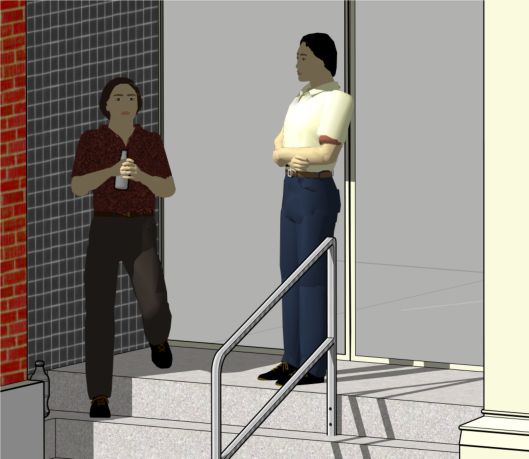
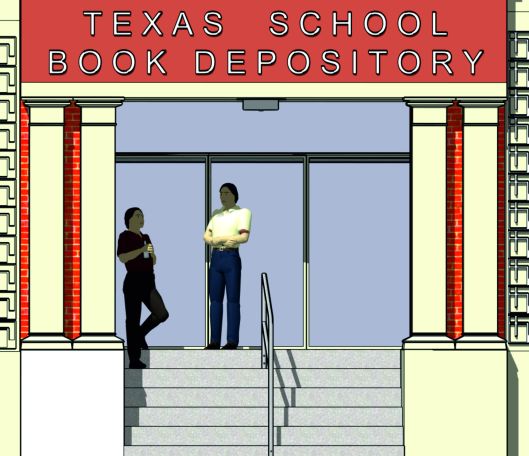
Hello Andrej
I really like the approach you have taken to analyse this issue and have been following the discussion on EDF you had with Ray with interest. The tool you have developed goes well beyond my capabilities.
A while back I sent you a message on the ROKC site suggesting an alternative interpretation of the positioning of Prayerman (I’m not sure if you have had a chance to read it). My interpretation is as follows (in the Darnell picture): PM is leaning his right shoulder against the wall; he has his arms folded in front of his chest – left arm over the right; the light patch hits the outside of his left elbow (not his hand); the light bit to his left (our right) is the radiator in my interpretation (not his left elbow).
This leaves PM in a typical masculine posture, leaning against the wall at an angle with his right shoulder lower than the left, thus reducing his height compared to the erect standing Frazier.
I hope you would be interested to try this position out in your excellent tool.
Kind Regards
Chan
LikeLike
Hello Chan:
Many thanks for leaving a comment. I was pleased to read that you liked my approach.
The exact orientation of PM’s body and arms could perhaps be tweaked better. As per PM’s arms, I think he holds a sandwich in his left hand. It is a long story why I think so, and I will come to it in few weeks or, more likely, in few months.
As per orientation of Prayer Man’s trunk, again I agree it could have been solved perhaps better. However, the work with human pose able models is the most difficult part and takes me most of the time. If you agree, I would come back to trying few new body postures later when my overall project is complete.
Thanks also for your previous post via ROKC; I apologise for not responding, I am not active on ROKC at the moment, and due to my busy job can hardly handle one forum, which is the EF on this occasion.
In the next weeks, I will open a new thread called Doorway puzzles on EF, and will go from the bottom of the doorway to the top to fit every occupant where he/she was 53 years ago. I hope you will be able to follow this work too.
Again, many thanks for your comment.
Best wishes
Andrej
LikeLike
An excellent rendering of all possible options, Andrej, way to go. Am glad Mr. Larsen and Mr. Mitcham were able to share some key points with you. Also am inclined to agree with Chan’s assessment in that Prayer Man is leaning as oppose to standing in a fully erect position. Will bookmark your site so I may stay abreast of any new developments. Appreciate your contributions to date.
LikeLike
Thanks, Alan, for your kind evaluation of this work. I am currently working on a much more realistic reconstruction of Darnell’s still. It will address Prayer Man’s specific body posture, which both you and Chan have pointed to. I have now employed Poser 11 program which allows to create realistic 3D human models in anatomically appropriate postures, and hope to post this new work in few weeks time.
LikeLike